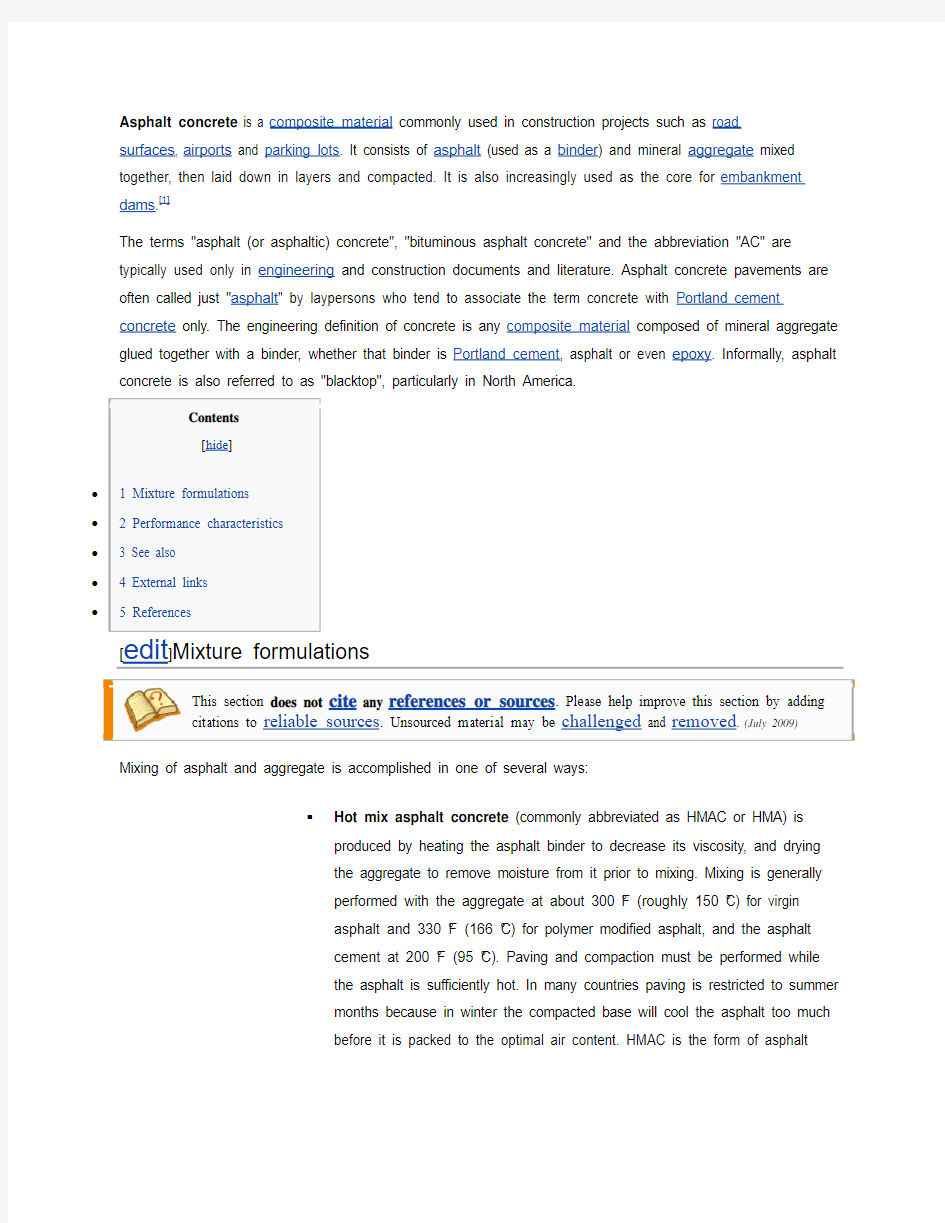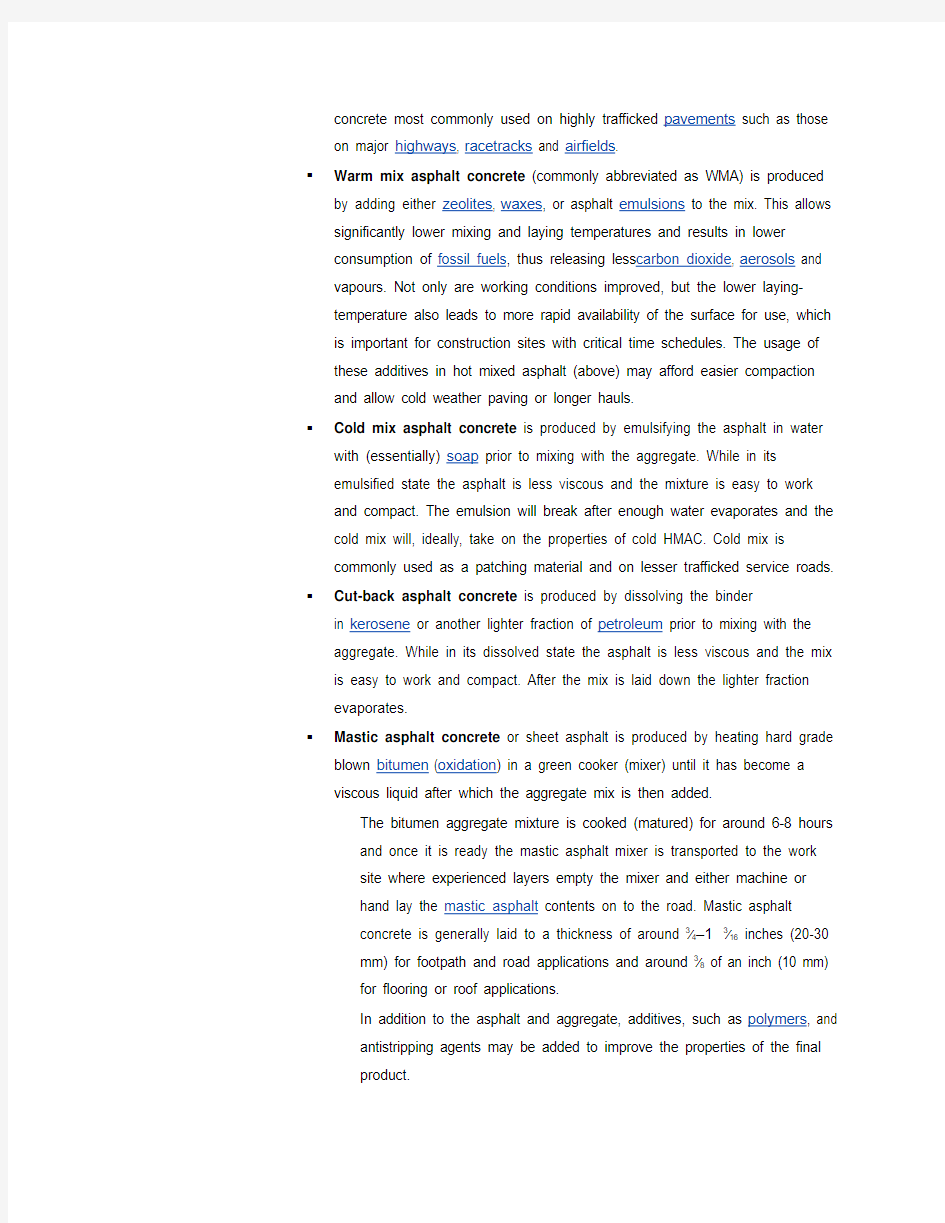

?
?
?
?
?
Mixing of asphalt and aggregate is accomplished in one of several ways:
Hot mix asphalt concrete (commonly abbreviated as HMAC or HMA) is
produced by heating the asphalt binder to decrease its viscosity, and drying
the aggregate to remove moisture from it prior to mixing. Mixing is generally
performed with the aggregate at about 300 °F (roughly 150 °C) for virgin
asphalt and 330 °F (166 °C) for polymer modified asphalt, and the asphalt
cement at 200 °F (95 °C). Paving and compaction must be performed while
the asphalt is sufficiently hot. In many countries paving is restricted to summer
months because in winter the compacted base will cool the asphalt too much
before it is packed to the optimal air content. HMAC is the form of asphalt
concrete most commonly used on highly trafficked pavements such as those on major highways, racetracks and airfields.
?Warm mix asphalt concrete (commonly abbreviated as WMA) is produced by adding either zeolites, waxes, or asphalt emulsions to the mix. This allows significantly lower mixing and laying temperatures and results in lower
consumption of fossil fuels, thus releasing less carbon dioxide, aerosols and vapours. Not only are working conditions improved, but the lower laying-
temperature also leads to more rapid availability of the surface for use, which is important for construction sites with critical time schedules. The usage of these additives in hot mixed asphalt (above) may afford easier compaction and allow cold weather paving or longer hauls.
?Cold mix asphalt concrete is produced by emulsifying the asphalt in water with (essentially) soap prior to mixing with the aggregate. While in its
emulsified state the asphalt is less viscous and the mixture is easy to work and compact. The emulsion will break after enough water evaporates and the cold mix will, ideally, take on the properties of cold HMAC. Cold mix is
commonly used as a patching material and on lesser trafficked service roads. ?Cut-back asphalt concrete is produced by dissolving the binder in kerosene or another lighter fraction of petroleum prior to mixing with the aggregate. While in its dissolved state the asphalt is less viscous and the mix is easy to work and compact. After the mix is laid down the lighter fraction
evaporates.
?Mastic asphalt concrete or sheet asphalt is produced by heating hard grade blown bitumen (oxidation) in a green cooker (mixer) until it has become a
viscous liquid after which the aggregate mix is then added.
The bitumen aggregate mixture is cooked (matured) for around 6-8 hours
and once it is ready the mastic asphalt mixer is transported to the work
site where experienced layers empty the mixer and either machine or
hand lay the mastic asphalt contents on to the road. Mastic asphalt
concrete is generally laid to a thickness of around 3?4–1?3?16 inches (20-30
mm) for footpath and road applications and around 3?8 of an inch (10 mm)
for flooring or roof applications.
In addition to the asphalt and aggregate, additives, such as polymers, and
antistripping agents may be added to improve the properties of the final
product.
Natural asphalt concrete can be produced from bituminous rock, found in some parts of the world, where porous sedimentary rock
near the surface has been impregnated with upwelling bitumen.
A landing strip, one of the uses of asphalt concrete
Asphalt concrete is often touted as being 100% recyclable. Several in-place recycling techniques have been developed to rejuvenate oxidized binders and remove cracking, although the recycled material is generally not very water-tight or smooth and should be overlaid with a new layer of asphalt concrete. Asphalt concrete that is removed from a pavement is usually stockpiled for later use as a base course material. This reclaimed material, commonly known by the acronym 'RAP' for recycled or reclaimed asphalt pavement, is crushed to a consistent gradation and added to the HMA mixing process. Very little asphalt concrete is actually disposed of in landfills. Sometimes waste materials, such as rubber from old tires, are added to asphalt concrete as is the case with rubberized asphalt, but there is a concern that the hybrid material may not
be recyclable.
Asphalt damaged by cryoturbation, or freezing of groundwater.